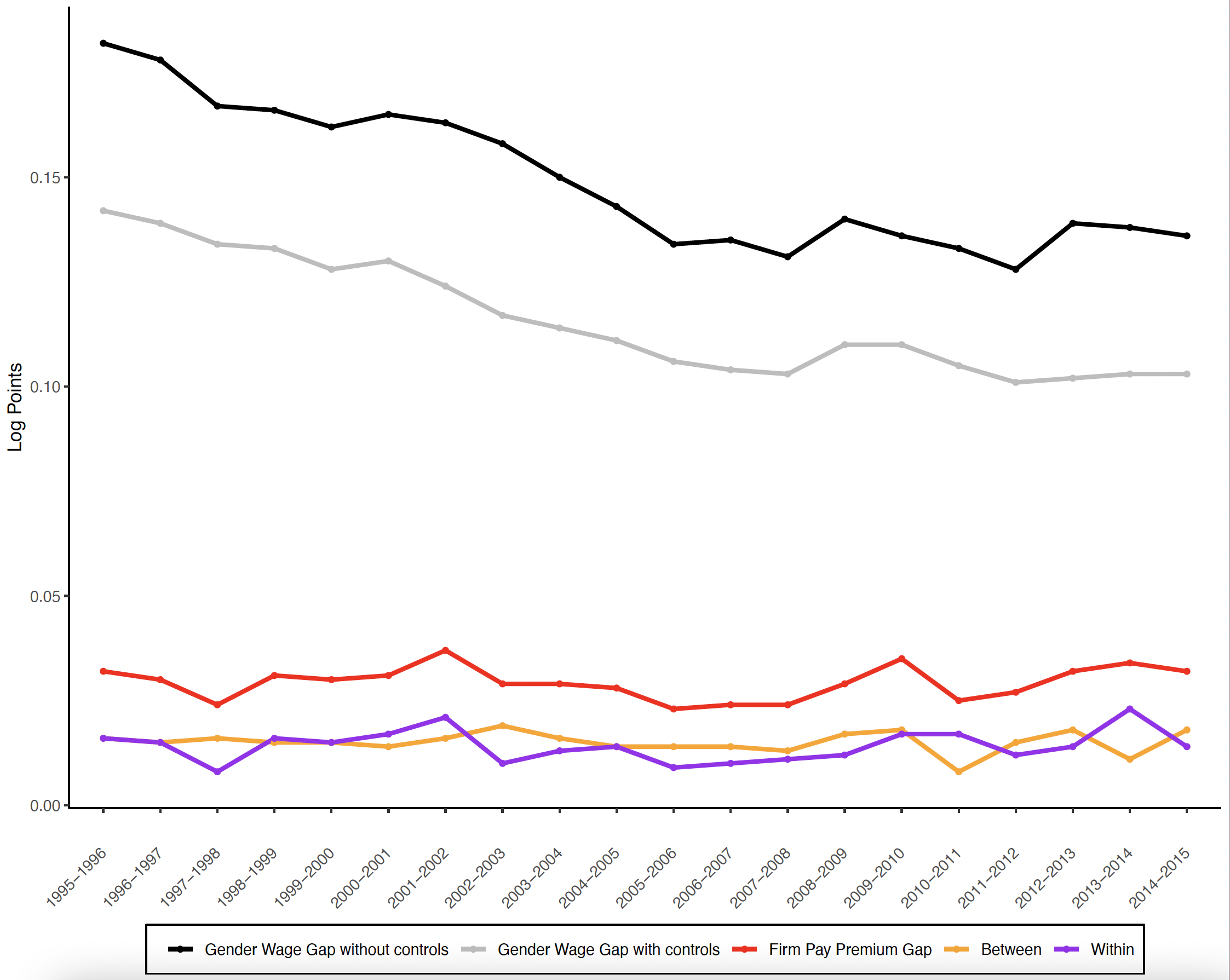Understanding what drives differences in wages between women and men has been the subject of economic research for decades (Olivetti and Petrongolgo 2016, Blau and Kahn 2017), and the effects of various policies aimed at reducing the gap has generated considerable debate (Bennedsen et. al 2020). Recent research examining the role that firms play in contributing to the gender wage gap aims to separate two important drivers: (1) the extent to which women sort into lower paying firms, and (2) the extent to which women extract less surplus than men within a given firm. In particular, the seminal work of Card et al. (2016) assesses the impact of firm-specific pay policies on the gender wage gap by estimating gender-specific firm pay premiums. This methodology allows the researcher to compute a gender gap in firm pay premiums and to decompose it into a ‘sorting’ or ‘between’ firm channel (what women would be paid if they worked at the firms where men work) and a ‘bargaining’ or ‘within’ firm channel (what women would be paid at these firms if they were men).
The empirical application in Card et al. (2016) uses Portuguese data, but several papers have since leveraged this methodology to study other contexts, including Germany (Bruns 2019), Italy (Casarico and Lattanzio 2019), and Brazil (Morchio and Moser 2020). Although magnitudes vary across countries, results consistently show that sorting between firms explains most of the firm component of the gender wage gap. In other words, gender differences in pay premiums are largely driven by men and women working in different firms rather than similar men and women being paid differently at the same firm.
While the gender gap in firm pay premiums is therefore well documented, there is less evidence of how this gap – and its decomposition into between-firm and within-firm differences – has evolved over time and changes over the life cycle. There is also little evidence on whether men and women benefit differently from match effects, i.e. from complementarities between their type and their firm’s type. In a recent working paper (Palladino et al. 2021) we aim to address these gaps.
To shed light on these research questions, we leverage new insights from Bonhomme et al. (2019) and cluster firms into sufficiently similar groups. This methodology has several nice estimation properties which we discuss in more detail in our working paper. Importantly, it allows us to look at much shorter panels of data, which are better suited to investigating how the gender wage gap and its components have changed over time and over the life cycle. Though not discussed here, our working paper also explores whether men and women benefit differently from ‘match effects’ or complementarities between the type of firm they work in and their own type.
Our data come from matched employer-employee registers in France (DADS data) from 1995 to 2015. We have information on hours worked such that our main wage measure is the hourly wage. On average in our sample, men and women are 40 years old. Women earn on average €28,000 gross per year, while for men the figure is €35,000; 27% of women are part-time and 7% of men.
Figure 1 tracks the evolution of the contribution of firms to the gender pay gap between 1995 and 2015 using overlapping two-year panels from our data. The top black line shows the unconditional gender gap in hourly wages in France. The gap has fallen considerably from 18% to 13%. The decline is similar when we include controls for age, experience, tenure, and occupation. This is represented by the grey line just below the black line. On the other hand, the gender gap in firm pay premiums has remained fairly stable over these two decades at around three to four log points with no sign of decline. Thus it represents an ever increasing share of the gender wage gap and is about the same size as the effect explained by all the control variables above (the difference between the black and grey lines). The decomposition of these firm premiums into its between (sorting) and within (bargaining) components also reveals little change over time across these two components.
Figure 1 The evolution of the contribution of firms to the gender wage gap over time
Note: The black line gives the unconditional gender gap in hourly wages. The grey line gives the gender gap in hourly wages, controlling for a polynomial in age, experience, and tenure as well as two-digit occupations. The red, orange, and purple lines give the gender gap in firm pay premiums and its decomposition.
Another advantage of the cluster methodology we use is that we are able document the evolution of the contribution of firms to the gender pay gap over the life cycle using age-specific estimates. For example, we can examine the gender gap in firm pay premiums specifically for workers between 25 and 30 years old without relying on estimates derived from the entire age range. This is because estimating ‘cluster effects’ instead of ‘firm effects’ requires less stringent sample restrictions than traditional regressions with both worker and individual firm fixed effects, which are commonly done using methods proposed by Abowd et al. (1999). This allows us to document not only the life cycle pattern of the gender gap in firm pay premiums but also its evolution by cohort.
The results are presented in Figure 2. First, we observe that the unconditional gender pay gap increases over the first part of the life cycle but remains relatively flat after about age 40 (panel a). The gap has also declined for each subsequent cohort. The gender gap in firm pay premiums (panel b) increases over the life cycle and we observe almost no differences across cohorts. Interestingly, there is little evidence that the ‘within’ component increases over the life cycle or that it has changed substantially across cohorts (panel c). It is really the ‘between’ firm or sorting component that increases over the life cycle, accounting for the rise in the overall firm pay premium gap. This ‘between’ component has remained similar across subsequent cohorts of workers (panel d). In sum, despite substantial age heterogeneity, there is much less cohort heterogeneity in firm effects consistent with the evidence on changes over time.
Figure 2 The evolution of the contribution of firms to the gender wage gap over the life-cycle
Note: This figure reports, by age and cohort, estimates of the unconditional gender wage gap (panel a), of the gender gap in firm pay premium (panel b), and of its decomposition into a within (panel c) and between (panel d) components. We use overlapping five-year age brackets. We compute averages of these estimates by gender, age, and cohort. For each specific age, the value shown on the figure corresponds to the average value for the five brackets that include it.
What does all this tell us? First, there has been an important decline in the gender wage gap in France over the past few decades. However, very little of the decline either over time or across cohorts can be explained by firms. The portion of the gap explained by firms is significant (as large as occupational difference) but has not decreased. As a result, firms play a larger role in the remaining gender wage gap than they did 20 years ago. Similarly, while we find a ‘lifecycle’ effect in the gender wage gap – gender wage gaps increase until about age 40 and then remain fairly flat – this gap has also declined for more recent cohorts. But once again, this is not due to changes in the role of firms. As with our time-series evidence, we find almost no change across cohorts in the share of the gap explained by firm premiums. In our view, understanding why the share of the gender gap explained by firms has been so immoveable over time and across cohorts will be a key policy puzzle for those interested in reducing wage gaps further.
References
Abowd, J M, F Kramarz and D N Margolis (1999), “High wage workers and high wage firms”, Econometrica 67: 251–333.
Bennedsen, M, E Simintzi, M Tsoutsoura and D Wolfenzon (2020), “Pay transparency and its effect on the gender pay gap”, VoxEU.org, 07 May.
Blau, F D and L M Kahn (2017), “The Gender Wage Gap: Extent, Trends, and Explanations”, Journal of Economic Literature 55: 789–865.
Bonhomme, S, T Lamadon and E Manresa (2019), “A distributional framework for matched employer employee data”, Econometrica 87: 699–739
Bruns, B (2019), “Changes in Workplace Heterogeneity and How They Widen the Gender Wage Gap”, American Economic Journal: Applied Economics 11: 74–113.
Card, D, A R Cardoso and P Kline (2016), “Bargaining, sorting, and the gender wage gap: Quantifying the impact of firms on the relative pay of women”, The Quarterly Journal of Economics 131: 633–686.
Casarico, A and S Lattanzio (2019), “What Firms Do: Gender Inequality in Linked Employer-Employee Data”, WorkINPS Papers No. 24.
Morchio, I and C Moser (2020), “The Gender Pay Gap: Micro Sources and Macro Consequences”.
Olivetti, C and B Petrongolo (2016), “The Evolution of Gender Gaps in Industrialized Countries”, Annual Review of Economics 8: 405–434.
Palladino, M, A Roulet and M Stabile (2021), “Understanding the role of firms in the gender wage gap over time, over the life cycle and across worker types”, CEPR Discussion Paper No. 16671.








